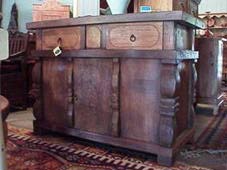

When so much reproduction furniture is available today from so many different origins such as Indonesia, Malaysia, Thailand and Mexico what is so special about the Spanish Provincial Furniture from the Philippines?
By itís very nature this style of furniture is so unique as to be unreproducable outside of itís native environment. The methods used in itís construction have long been replaced by super efficient machinery, the time required to produce a piece that will perform a similar function has been reduced to a fraction of what it would take by using the traditional hands on method. The precision of the finish is no longer in question and every piece will look the same as its predecessor. Gone is the need for fine timbers as reconstituted wood fibres will provide a much more economical result.
There-in lies your answer.
Every piece of fine Spanish Provincial Furniture whether it be old or new is Hand Crafted using traditional time consuming methods, the Finest Aged Tropical Hardwoods and is guaranteed not to be the same as any other piece produced simply because no two pieces of real timber are the same and when crafted by hand each piece will carry the signature trademarks of its creator.
Originating from the traditional furniture makers of the Mountain Province in the Northern Philippines, these most unusual items are constructed using strong, thick slabs of Molave and Narra either hand hewn or recycled from the buildings that collapsed during the 1990 earthquakes that devastated the area. One other point of major significance is that we guarantee that no timber has been logged from the rain forest to produce any piece of recently constructed furniture.
All joints are rebated dovetails carved by hand and although they may not appear as precise as machined joints they are however just as strong. There is very little electricity in the region and what is available is usually powered through petrol generators. No electric tools will touch these fine pieces and all work is carried out by hand. Pedal lathes are the principal means of attaining the fine turned legs of some tables and cabinets.
Slats are a further trademark of the region where the slatted style of cabinet is used for food storage and is called a "Pamingalan". Cabinets for clothing storage are decorative Spanish style units known as "Aparadors" and slatted central kitchen pieces sometimes used for chopping blocks are called "Gallieneras" or chicken cages.
The Spanish heritage is apparent in most of the furniture styles and furniture predating 1898, the time of the Spanish/American Revolution, exhibits distinctly Spanish carving usually on the tops of door panels and the crown atop a special cabinet. Later styles exhibit a distinct trend away from the ornateness of the Spanish influenced pieces and more towards an American Imperial quality of simpler lines and finer stylings.
Although these European and American influences have had an effect on the overall appearance of the furniture it still retains its distinctive Philippine origins and the flavour of the Far East is apparent in its function and originality.


